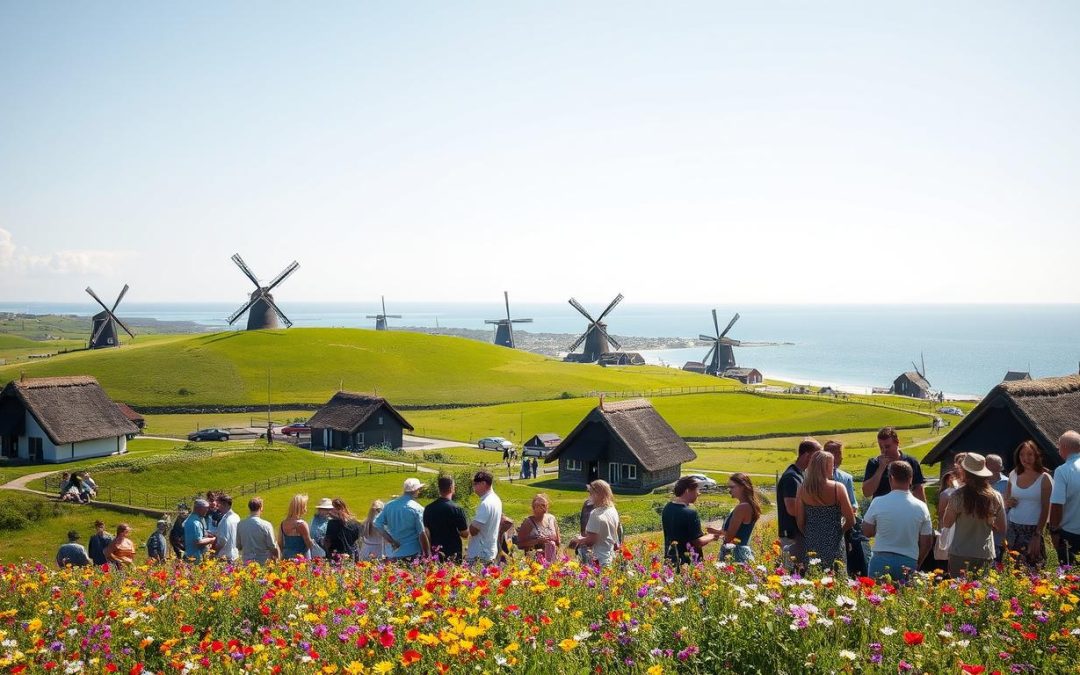Ever wondered how Denmark handles its many languages? It’s a small country with a big language story.
Danish is the main language of Denmark, spoken by 5.79 million people every day. It’s used for government, school, and culture across the country.
But Danish isn’t just for Denmark. About 6 million people around the world speak it. It comes from Old Norse, used by Vikings long ago. A big step was in 1550 when the Bible was translated into Danish, making the language more standard.
Exploring Denmark’s language scene shows a mix of Danish, English, and other languages. They all work together in a rich communication world.
Key Takeaways
- Danish is the primary official language in Denmark
- Approximately 6 million people speak Danish globally
- The language evolved from Old Norse during the Viking Age
- Danish has two grammatical genders: common and neuter
- The language plays a crucial role in national identity
Understanding Danish as the National Language
Danish is the vibrant native tongue of Denmark. It weaves a rich linguistic tapestry that connects millions. With about 5.5 million native speakers, it’s more than just a way to talk—it’s a cultural cornerstone of Danish identity.
Historical Development of Danish
The Danish language has its roots in the Viking Age. It evolved from Old Norse into a distinct language. Since the 9th century, it has developed a lot.
Linguists say Danish belongs to the North Germanic language family. It shares connections with Swedish and Norwegian.
- Originated from Old Norse dialects
- Developed unique sound structures
- Influenced by historical cultural exchanges
Modern Danish Usage and Importance
In today’s Denmark, Danish is key to national identity and communication. Over 90% of the population speaks it as their first language. It’s everywhere in social life, from schools to work.
| Language Context | Percentage |
|---|---|
| Native Danish Speakers | 90% |
| University Courses in Danish | 80% |
| Literacy Rate | 99% |
Danish Dialects and Regional Variations
Danish has a lot of linguistic diversity in its dialects. It’s considered one of the harder languages to learn. Each region adds its own twist, making the language rich and varied.
“Language is the road map of a culture. It tells you where its people come from and where they are going.” – Rita Mae Brown
Getting Danish means understanding its deep cultural roots and ongoing changes. From its Viking Age origins to today, Danish shows Denmark’s rich linguistic heritage.
Language Demographics in Modern Denmark
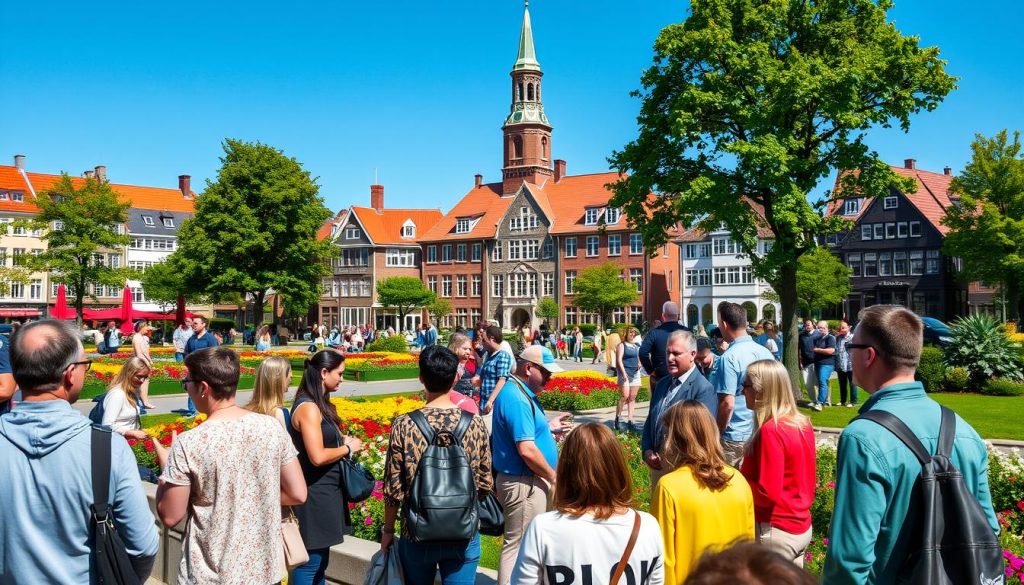
Denmark’s language scene is a mix of cultures and immigration. By 2022, about 15% of the people are immigrants or their kids. This adds a lot of language variety to the country.
The numbers show how languages and cultures blend together:
- Ethnic Danes: 87.7% of the population
- Immigrant population: 15% (886,748 individuals)
- Non-Western immigrants: 10%
- Western immigrants: 5%
The biggest groups adding to language variety are:
| Country of Origin | Percentage |
|---|---|
| Türkiye | 7% |
| Poland | 6% |
| Syria | 5% |
Immigration trends show Denmark’s changing language scene. From 2000 to 2020, the number of immigrants changed a lot. The highest number was in 2015, with 78,502 people.
“Language is the road map of a culture. It tells you where its people come from and where they are going.” – Rita Mae Brown
Understanding Denmark’s language diversity is more than just numbers. It shows a lively social scene where many languages meet. This makes Denmark’s culture richer.
Official Language Policy and Legislation
Denmark has a clear plan for its official language. Danish is the only official language and is key in government, schools, and national identity. The laws about language show Denmark’s dedication to keeping its language alive while welcoming different languages.
The Danish government has started several important projects to help the official language:
- Comprehensive language preservation programs
- Structured support for Danish language education
- Legal protections for linguistic rights
Government Language Initiatives
Denmark sees Danish as the main way to talk. The government has made plans to keep the language strong:
- Funding for language research and development
- Support for cultural institutions promoting Danish language
- Integration programs for new residents
Educational Language Requirements
Schools are key in keeping the official language alive. Schools in Denmark have strict rules for Danish:
- Mandatory Danish language instruction
- Proficiency testing for academic progression
- Support for Danish language learners
Language Rights and Protections
Denmark has strong ways to protect language rights. The country balances keeping Danish alive with supporting other languages. Important protections include:
“Our language is our identity, and we work to preserve it while respecting linguistic diversity.” – Danish Language Council
- Legal framework for minority language rights
- Support for regional language communities
- International language rights agreements
Denmark’s language policy shows a careful balance. It keeps Danish strong while embracing the country’s diverse culture.
English Proficiency in Denmark
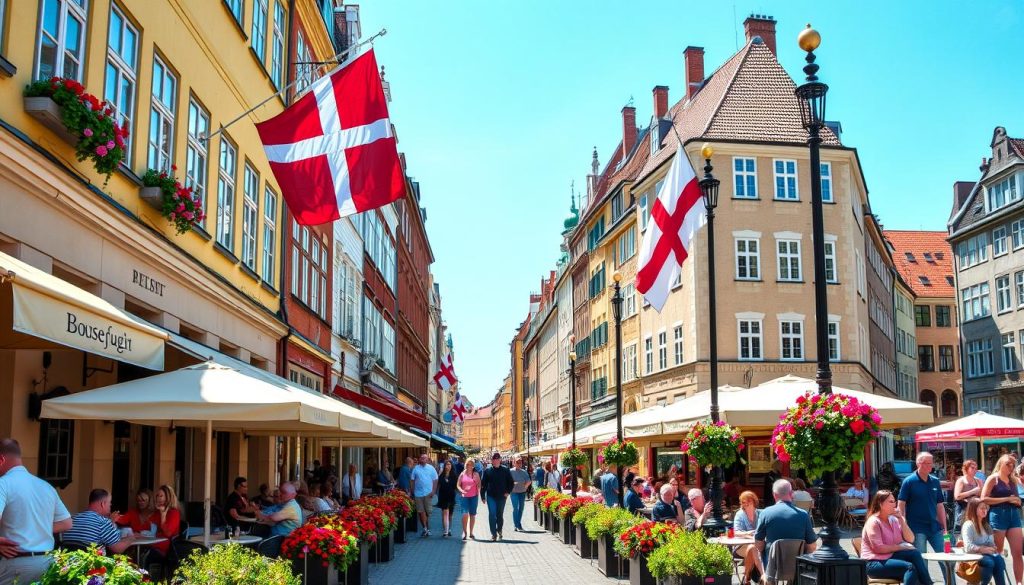
Denmark is a leader in English language skills. An amazing 86% of Danes speak English as a second language. This makes Denmark one of the most English-fluent countries worldwide.
Denmark’s education system is key to this success. English is taught from the first grade in public schools. This early start turns language skills into a national asset.
“Language is the key to understanding, and in Denmark, English opens many doors.” – Danish Language Education Expert
- English taught from first grade
- 86% of population speaks English
- Mandatory English education
- High global English proficiency ranking
Denmark’s focus on multilingualism is more than just talking. International companies love Danish workers for their language skills.
| Language Metric | Percentage |
|---|---|
| English Proficiency | 86% |
| International Students Annually | 30,000+ |
| Global English Proficiency Ranking | Top 5 |
Exploring Denmark’s language scene shows how education can make a country competitive. Denmark’s way of teaching English is a perfect example of embracing language diversity.
German Language Status and Usage
Denmark is not just about Danish. German is also a big part of the country’s language scene. It’s a minority language in Southern Denmark, showing the strong ties between Denmark and Germany.
German in Denmark is more than interesting. About 47% of Danes can speak German well. This shows how important German is for talking with people from other countries and sharing cultures.
German as a Minority Language
In Southern Denmark, German is an official minority language. This is because of Denmark’s long history with Germany. It has shaped the language scene near the border.
- Recognized as an official minority language in Syddanmark
- Significant cultural and economic importance
- Strong cross-border communication
Historical Context of German in Denmark
German has deep roots in Denmark. This is thanks to centuries of being close to Germany and sharing cultures. The border areas are a mix of languages and cultures, making a special place.
“Language is the road map of a culture. It tells you where its people come from and where they are going.” – Rita Mae Brown
Current German Language Education
Danish schools teach German as a key third language. They see its value in school and for jobs. Many students learn German for business, travel, and to understand different cultures.
| Language Learning Statistic | Percentage |
|---|---|
| Danes speaking conversational German | 47% |
| German as a third language in schools | High priority |
| Cross-border communication importance | Significant |
German is a big part of Denmark’s language mix. It shows Denmark’s support for speaking many languages and understanding different cultures. German is key for business, learning, and making friends.
Other Minority Languages in Denmark
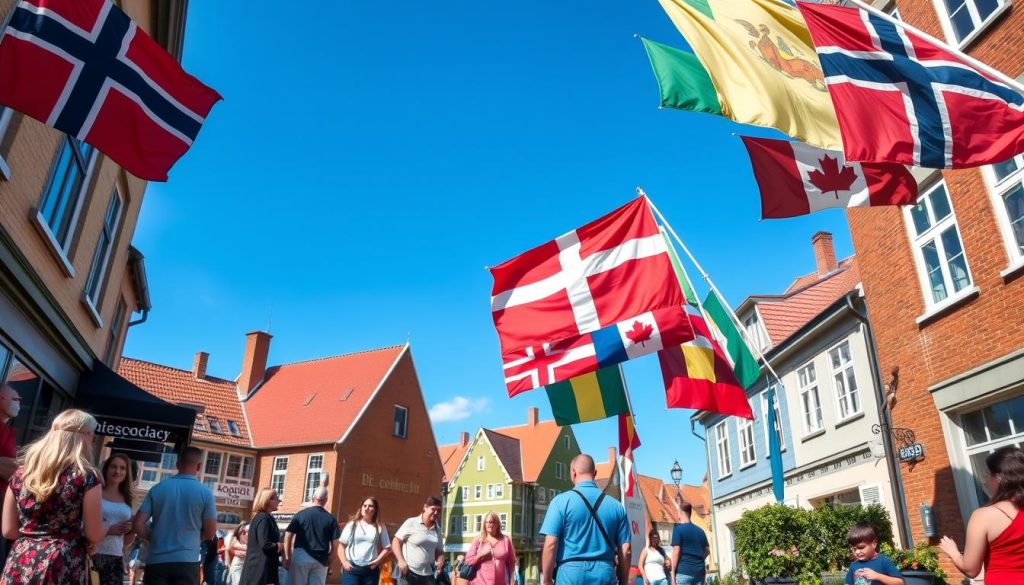
Denmark is more than just Danish. It has a rich mix of minority languages. These languages show the country’s diverse culture.
Immigrant communities have added to Denmark’s language mix. Key minority languages include:
- Romani
- Arabic
- Turkish
- Polish
- Kurdish
These languages come from Denmark’s diverse immigrant groups. They add to the country’s cultural richness.
“Language is the road map of a culture. It tells you where its people come from and where they are going.” – Rita Mae Brown
Keeping language diversity alive is tough. Denmark offers some language support, but it’s limited. Free language training is available, but it’s not enough for everyone.
New refugees get language classes, but some say they’re not good enough. This has raised concerns.
Studies show immigrant families often lose their native language over time. The first and second generations might speak two languages. But later generations often choose Danish as their main language.
This shows Denmark’s cultural landscape is changing. The mix of native and Danish languages shows the country’s ongoing cultural journey.
Faroese and Greenlandic as Regional Languages
Denmark’s language scene goes beyond its mainland. It includes special regional languages that show off the rich culture of its territories. The Faroe Islands and Greenland have their own unique languages, showing Denmark’s dedication to keeping official languages and cultural identities alive.
Faroese Language Communities
The Faroe Islands are a special place for language. Faroese, a direct descendant of Old Norse, is spoken by about 66,000 people in a population of 53,000. This shows how strong and vibrant the language is. It keeps its Nordic roots but also has its own unique identity.
- Spoken by nearly 100% of the Faroese population
- Official regional language within the Faroe Islands
- Closely related to Icelandic
- Reflects deep historical linguistic traditions
Greenlandic Language Status
Greenlandic is a key part of indigenous language diversity. It’s the only official language in Greenland, showing the Inuit culture’s strength. About 57,000 people, or 90% of Greenland’s population, speak Greenlandic as their main language.
| Language Characteristic | Faroese | Greenlandic |
|---|---|---|
| Total Speakers | 66,000 | 57,000 |
| Percentage of Local Population | ~100% | ~90% |
| Official Status | Regional Official Language | Primary Official Language |
“Language is the roadmap of a culture. It tells you where its people come from and where they are going.” – Rita Mae Brown
Both Faroese and Greenlandic show Denmark’s commitment to language diversity. They ensure these special languages keep growing, alongside Danish. Keeping them alive is more than just talking; it’s a deep connection to culture and identity.
Language Education System in Danish Schools
Denmark’s language education system is a top example of linguistic excellence. The Danish language is at the heart of learning, preparing students for the world.
Starting early, Danish schools focus on language learning. Students learn English from the first grade. This shows Denmark’s dedication to teaching many languages.
- English instruction begins in primary school
- A second foreign language (typically German or French) is introduced in later grades
- 82% of young people pursue further education beyond primary school
The Danish education system balances keeping the native language strong with learning international languages. Compulsory education spans from ages 5-6 to 15-16. This ensures students get a solid base in Danish and other languages.
| Education Level | Language Focus | Additional Details |
|---|---|---|
| Primary School | Danish + English | Foundational language skills |
| Secondary Education | Danish + English + Optional Third Language | Advanced language preparation |
| Higher Education | Multilingual Approach | International communication skills |
“Our language education prepares students not just for Denmark, but for the world.” – Danish Education Expert
Denmark has a 99% literacy rate and invests a lot in education. This makes its language teaching a global example of success in learning many languages.
Business Communication and Language Practices
Denmark’s business world shows a lot of language diversity. Companies use smart language skills to reach out to the world. They adapt their communication to fit global markets.
Looking into Danish business language practices, we find some important points:
- About 80% of Danes speak and understand English well
- Business talks are direct and to the point
- Workplaces value equality and have few levels of authority
Corporate Language Policies
Danish companies have flexible language rules. They focus on clear, simple communication. Most businesses expect employees to speak at least two languages well.
“In Denmark, language is not just a tool, but a bridge to global opportunities.”
International Business Language Requirements
To succeed in Denmark’s job market, you need good language skills. English is key for international business. Knowing Danish is also helpful for local talks.
| Language | Business Importance | Proficiency Level |
|---|---|---|
| English | High | Essential |
| Danish | Local Significance | Recommended |
| German | Regional | Beneficial |
Danish businesses use language diversity to stay ahead. They are seen as innovative and competitive worldwide.
Immigration Impact on Language Diversity
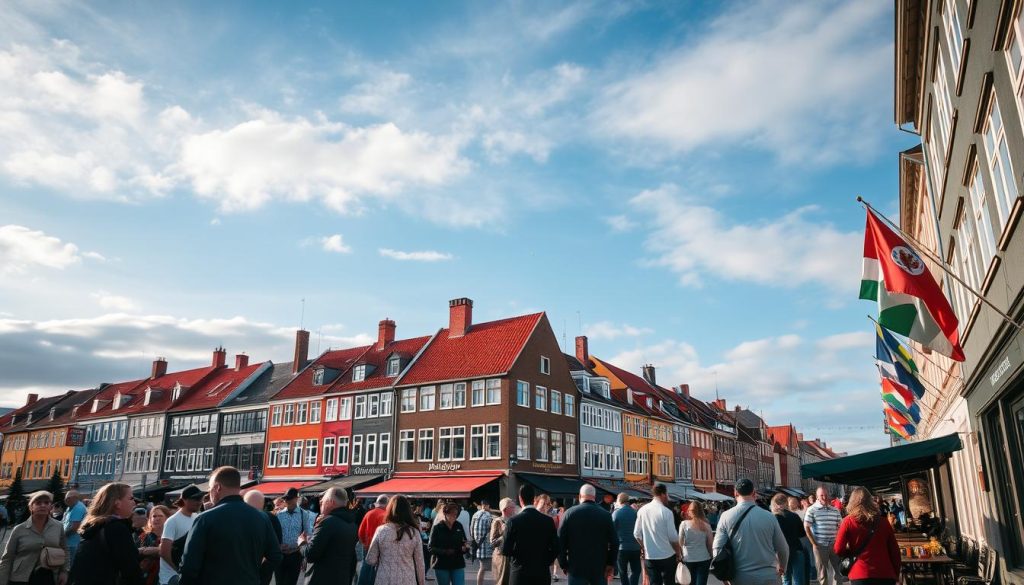
Denmark’s language scene has changed a lot because of immigration. Since World War II, the country has seen big changes in its people. Now, 14% of Denmark’s population are immigrants and their families, adding to the language mix.
Immigrants have brought many languages to Denmark. Some of these include:
- Arabic
- Turkish
- Urdu
- Polish
- Romanian
Danish schools are key in keeping languages together. They make sure all students learn Danish well. This helps keep the national language strong while also celebrating different languages.
“Language is the roadmap of a culture. It tells you where its people come from and where they are going.” – Rita Mae Brown
Immigration has really changed Denmark’s language world. The biggest times of immigration were:
- Late 1960s-1970s: Workers from Turkey, Yugoslavia, and Pakistan
- 1990s: Mostly refugees
- Post-2004: Workers from Central and Eastern Europe
| Immigration Period | Primary Immigrant Groups | Language Impact |
|---|---|---|
| 1960s-1970s | Turkish, Yugoslav, Pakistani workers | Introduction of Arabic, Turkish, Urdu |
| 1990s | Refugees from conflict zones | Expanded linguistic diversity |
| Post-2004 | Central and Eastern European workers | Added Polish, Romanian languages |
Denmark values its Danish language a lot. Even in small towns, Danish is the main language for business and everyday talk. This keeps Danish important in work and daily life.
Conclusion
Exploring Denmark’s language shows a great balance. The Danish language is strong, with over 98% of people speaking it well. At the same time, the country is very good at speaking many languages.
Denmark’s language shows its forward-thinking spirit. With nearly 6 million people and most living in cities, the country values many languages. It’s known for its English skills, respect for minority languages, and modern education.
The Danish language is changing, thanks to the world around it. Immigration and new technology are making it evolve. Denmark is a great example of how to keep your language alive while being open to the world.
Denmark’s language plan looks bright for the future. It values its own language but also stays current with global trends. This way, Denmark keeps its language lively and connected to its culture.
The above is subject to change.
Check back often to TRAVEL.COM for the latest travel tips and deals.
Here are some Tours & Sightseeing suggestions that might pique your interests!
